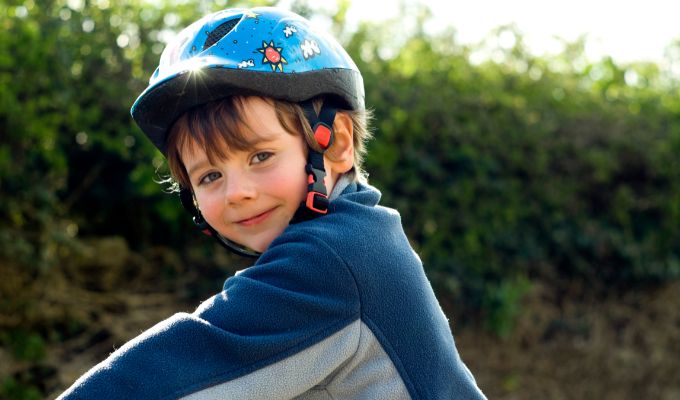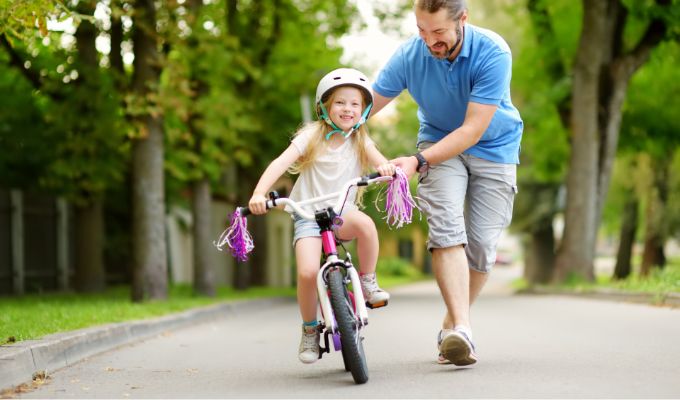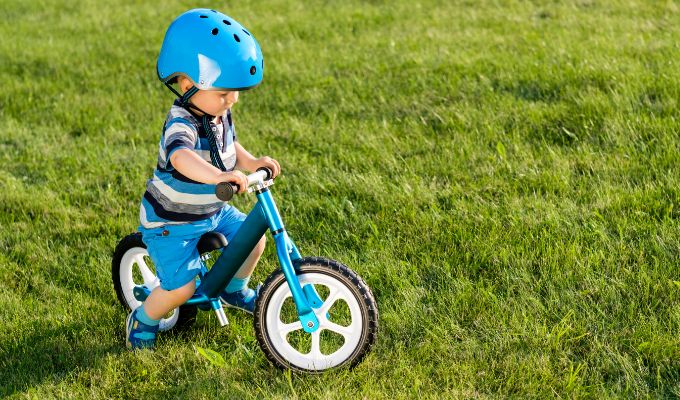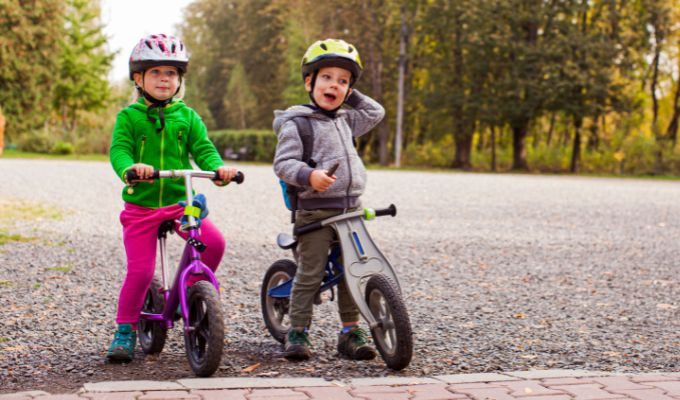Whether for the first bike trip with mum and dad or the first attempt at riding a balance bike or scooter – a children’s bicycle helmet that has proven itself in tests is simply a must. The best child safety helmets also have excellent impact absorption, head protection, and comfort.
There is no doubt that kids should only ride balance bikes or bicycles while wearing a helmet that fits their heads exceptionally well and offers them the best protection. We display the top child bicycle helmets for you.
You must wear a helmet if you are riding a bike. In theory, this holds true for all cyclists, at any age and experience level, whether you’re a clumsy kid or a tour de France athlete. But for young cyclists, it’s particularly important.
What qualities distinguish a decent child’s bicycle helmet, and what should parents pay attention to? In this guide, we’ll discuss helmet selection tips, and provide a roundup of the best riding helmets for ages 2 – 4.
ABUS Smiley 3.0 ACE LED Children’s Bike Helmet
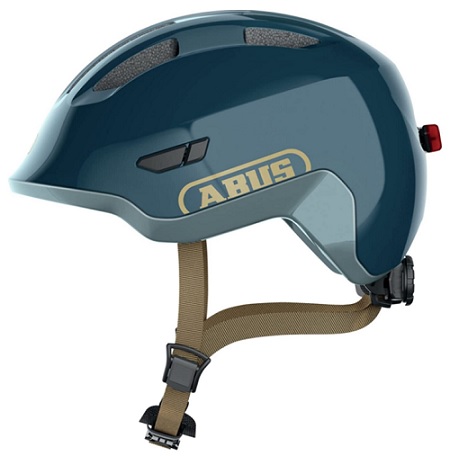
The popular Abus Smiley 2.0 children’s cycling helmet embodies the safety reputation of the Abus brand. One of the best-selling kids’ helmets on Amazon offers increased protection at the front and back for little bikers and cyclists.
In the case of a fall, the visor-like front edge shields the face, while the back of the head is protected by the low temple and neck region. The children’s helmet is made utilising the in-mould technology, which involves securely welding the outer shell to the shock-absorbing foam. As a result, it is far more durable than helmets that are glued at specific locations.
A mosquito net keeps biting insects from getting lost in the helmet, and eight air vents in the helmet ensure that the child’s head does not overheat. The built-in LED illumination and reflective surface help with visibility at night.
- Helmet construction: sturdy Polypropylene shell and shock-absorbing foam
- Sizes: M or S (45–50 cm) (50-55 cm)
- Adjustable: Size adjust wheel at the back of the helmet
- Ventilation: 8 air inlets for ventilation, together with a mosquito net
- Lights: Yes, red rear
- Weight: Super lightweight at just 230g
Alpina Children’s Radhelm Ximo Flash Helmet
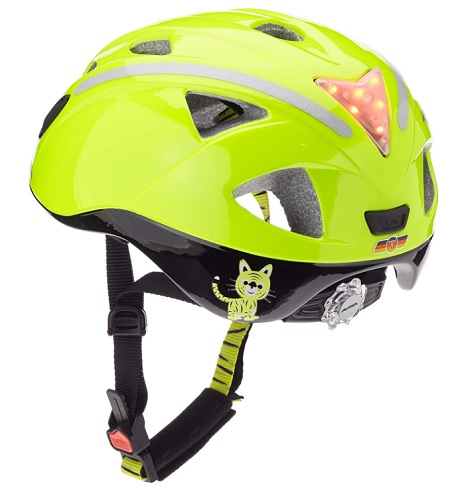
The Alpine Ximo Flash children’s bicycle helmet has many features that make it a safe and pleasant helmet for toddlers. The manufacturing method results in a lightweight and durable micro-shell helmet.
The ventilation openings are designed in such a manner that they block the sun’s rays while yet allowing adequate air to flow across the child’s head.
Reflective components and an LED light on the back of the helmet make it easily visible even in the dark. Children are glad that the helmet is so flat at the back that it does not get in the way when leaning on the child seat or bicycle trailer, and parents are happy that the size adjustment and chin strap are straightforward.
The heat resistance and pollutant categories were excellent for the Alpino Ximo Flash helmet. It features a sporty cut and is an excellent alternative for older kids to cycling and inline skating, and of course, balance biking.
- Micro-shell helmet design: outer shell and EPS foam bonded over the entire surface
- Sizes: 45-49 cm, 47-51 cm, or 49-54 cm with size adjustment via plastic wheels behind the head twist-proof, multi-stage ratchet closure for individual belt adjustment
- Vents: 11 ventilation apertures, with fly mesh on the front ones.
- Lighting: Yes, LED rear light with reflecting components
- Weight: Approx. 229g
ABUS Youn-I 2.0 Helmet with light for children
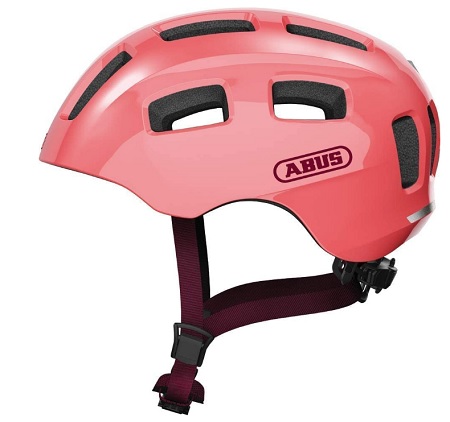
In testing, the ABUS Youn-I 2.0 can handle some serious knocks, and offered a little more protection against potential head injuries than the competition.
The helmet may be quickly and effectively adjusted to your child’s head size using the simple adjustment wheel that is attached to the complete ring on the inside of the helmet. It also provides delightful ventilation and excellent wearing comfort thanks to the numerous air vents covered in fly nets. The reflectors and LED rear light ensure your youngster is visible from a distance.
- Helmet structure: sturdy lightweight shell build onto high-impact hard foam inner
- Sizes: M or S (48-54 cm) (52-57 cm)
- Airflow: 8 air inlets, 9 air exits, and an insect net are used for ventilation.
- Lighting: reflectors and an LED backlight
- Weight: 240g
- Available in a variety of elegant decor
Uvex Unisex-Youth Helmet
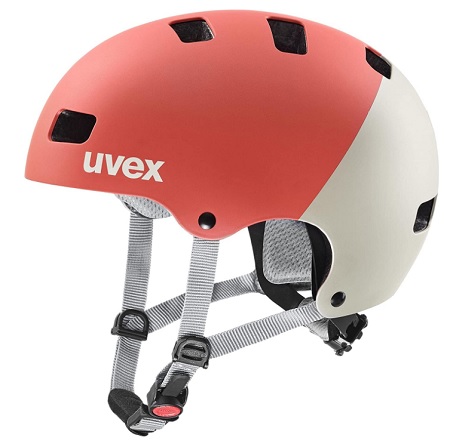
One of the most well-liked children’s bike helmets in the Uvex Kid 3 line. One reason for this is the stylish design combined with high-rated security and comfort features.
It has ten ventilation ports, unlike the majority of skater helmets, to reduce heat buildup inside the helmet. The Uvex helmet monomeric closure, which can be opened with one hand, and the simple-to-use adjustment choices are both useful. Maximum safety is assured by the hard shell construction, which consists of an impact-resistant outer shell and a shock-absorbing EPS inner shell.
- Hardshell helmet made of an impact-resistant outer shell and an inner shell of shock-absorbing EPS.
- Sizes: 51-55 cm or 55-58 cm, skater-style, with deep back head protection
- Using a little plastic wheel at the back of the skull’s Uvex monomatic closure that can be turned with one hand, the head circumference can be adjusted.
- 10 apertures for ventilation
- Weights between 350 and 370g depending on size choice
Next: Tips for Parents on Teaching a Child to Ride a Bike
6 Buying Criteria: How to Choose the Best Helmet for Your Child
Bicycle helmets are available in a wide range of sizes, forms, designs, and pricing points. When purchasing a children’s bicycle helmet, consider the following six factors:
The shape
Not every helmet is suitable for every head. That is why it is critical to try on various models. In this manner, you can easily determine which helmet form and padding size are appropriate for your child.
Set a positive example as a parent by wearing a well-tested helmet, so they’ll instinctively wear theirs, whether cycling, balance biking, or scootering.
A helmet should protect your child’s temples, and face, in addition to his or her head. However, the helmet should not fit too low on the neck, as this restricts movement.
Adjustability
A decent child’s helmet “grows with them.”
Make sure the helmet has many adjustment options to fit your child’s growing head. It sits securely on the head for a long period without being painfully tight or wobbly when properly set and with a comfortable cushion.
- The helmet should sit horizontally on your child’s head, about two finger widths above the brows, to provide the best protection.
- It must not rub against the neck or the brow.
- Your child’s head should only touch the padding of the helmet shell if the inner adjustment ring is snug.
- The straps should form a triangle an inch below the child’s ears.
- When two fingers can still fit between the child’s neck and the strap, the chin strap is properly adjusted.
Weight
A child’s helmet should not be overly hefty. It should weigh between 200 and 350 g. The lighter the helmet, the smaller the youngster.
Breathability
A proper ventilation system is required. It’s really uncomfortable if your youngster sweats under the helmet, and it can lead to overheating. As a result, it is critical that the helmet be permeable and have a strong ventilation system.
It is critical that your children are visible when cycling in traffic. As a result, the helmet should be colourful and eye-catching. Reflectors or LED lights are essential for making children visible in the dark. Of course, the bike requires proper lights.
Design and wearing comfort
Your child should like putting on the helmet. It sounds obvious, but don’t dismiss it when shopping for one: A helmet will only protect your child if he or she wears it. Let’s experiment with several safe models and designs. As a result, your child can select a bike helmet that fits comfortably and that they enjoy wearing.
A decent helmet should perfectly fit the head, be padded, and not be too heavy. It should have air holes, and the carrying straps should be able to seal and open tightly (there must always be a space of two fingers between the chin and the strap).
Teach Your Child That Helmets can save lives
Unfortunately, even the greatest cyclists can fall – and at speeds of 10 km/h, there is a risk of significant brain injury in bicycle accidents. At 16 km/h, the skull can no longer sustain an impact without injury, which is why doctors warn. Bicycle helmets save lives, both of youngsters and adults.
With kids around 2 years, they’re just learning to balance on their feet, so whizzing around on a balance bike is a whole new world of learning balance and coordination, which is going to result in some falls. It’s crucial at this starting stage of your childs biking journey that they wear correct head protection.
When are youngsters required to wear a bicycle helmet?
Even though helmets are not required in UK, it has been demonstrated that they greatly minimise the risk of severe head injuries. Therefore, it makes sense to familiarise youngsters with bicycle helmets as soon as feasible.
This means that as soon as they ride on a child’s bicycle seat or in a bicycle trailer, they must wear an appropriate bicycle helmet for children. Typically, this occurs after approximately a year. Then, when children can sit comfortably on their own and have well-developed trunk and neck muscles, they are able to wear bicycle helmets.
The correct size for child’s bike helmet
For effective head protection in the case of a fall, it is imperative that children’s bicycle helmets are selected in the correct size. If it is excessively loose, it may slip negatively during a fall or obstruct the view of the little rider on the balancing bike or bicycle.
If it is too small, it cannot cover all portions of the head sufficiently (forehead, temples, back of the head). It is essential to understand that size varies significantly between brands.
The sizes XS, S, and M can indicate something different on a Uvex children’s bicycle helmet compared to an Abus or Alpina helmet. Use the currently measured head circumference of your child as a guide when selecting the correct helmet size, and then consult the size chart of the respective children’s helmet brand. Common helmet sizing requirements for youngsters are as follows:
- Size XS: about 44-49 cm for children ages 3 and younger
- Size S: about 46-51 cm for children ages 2 to 7
- Size S/M: 49-53 cm for kids 3 to 9 years old
- M: 52-58 cm for children older than 4 years
If your youngster falls between two sizes, we suggest purchasing the larger one. Because a bicycle helmet for youngsters should fit tightly but not press on the head.
Always measure your child’s head before purchasing a helmet, and test fit before letting them ride.
Small children develop rapidly, so it is desirable to increase the size of the helmet before it must be replaced with a larger one. Particularly in the winter, you should also provide room for a cap.
Regardless of the age of the child, the skull shape has a significant impact on determining the correct size. Therefore, it is best to try on multiple bicycle helmets for children to get the ideal fit.
Fitting Advice
A bicycle helmet for children can only provide optimal protection in the event of a fall if it fits properly. This means that it neither wobbles nor pinches, is neither tilted upwards nor downwards, and provides equal protection to the forehead, temples, and back of the head. This is the optimal method for adjusting a child’s cycling helmet:
Place the bicycle helmet horizontally on your child’s head, so that the front edge of the helmet is at eyebrow level. Once the proper position has been determined, turn the adjustment wheel at the back of the head until the bicycle helmet for children is securely in place. If your youngster shakes his or her head, the helmet should not move.
Adjust the chin strap as follows: The straps should create a triangle around your child’s ear and be adjusted such that there is still a two-finger distance between the strap and his or her chin. The straps do not constrict the neck, but in the event of an accident, they secure the helmet so it cannot slip off.
Avoid trapping glasses: For youngsters who wear glasses, the frame and lenses should not touch the helmet.
